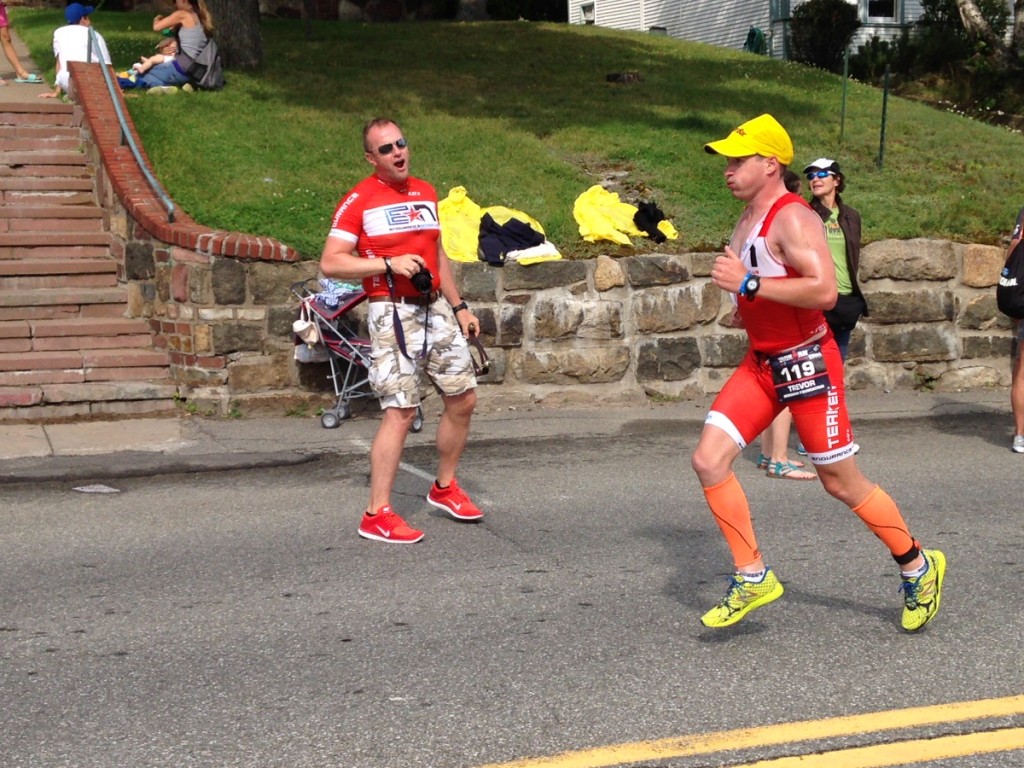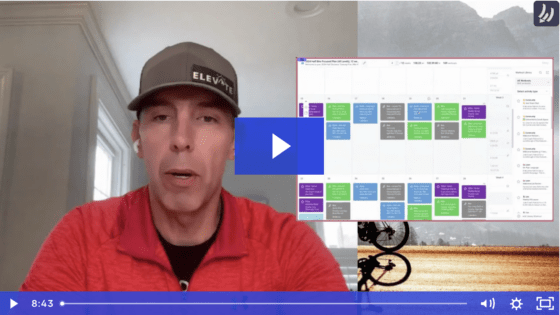Endurance excellence is an annual journey — repeated and improved — over time, that leads to fitness, confidence, experience and performance.
The next time you are watching some one race a triathlon, really race, take a moment to watch how they move. Try to forget about speed or gear or muscles for a second. A competitive triathlete, the complete package, is a smooth well-oiled machine.
In order to get the times and the results you want, you have to create your version of that machine. We all want to be fitter, faster and stronger, but it seems that there’s a surplus of desire (and capital!) in our growing sport. It’s simply not enough to want to be better, it’s about putting in the work.
In this four-part series of articles, I will be covering a process to set expectations relative to your upcoming season. In this first installment I will introduce the process of setting expectations and cover Part One: Defining A Great Race.
It’s Never As Simple As You Want It To Be…
By now you’ve probably figured out that you can’t simply buy a training plan or read a book either. If there was just one right way, well, we’d all know about it by now.
The truth is, we all see that amazing athlete and want to be just like her. I’m willing to be 50% of the triathletes who have seen Mirinda Carfrae run like the wind would be willing to make some unmentionable sacrifice to run just like her.
But she has made sacrifices. Mirinda’s fitness, her ability to perform, like any elite athlete, is the result of years of hard work. Of mistakes made. Of tweaks, changes, setbacks and lessons learned.
The Best Part About Triathlon?
But don’t be disheartened. For herein lies the best part of our sport — we can all be better if we are willing to put in the work required.
Exactly how much work is a function of:
(1) Where you are starting.
(2) Where you want to go.
(3) The means you chose to travel between those two points.
One Year = A Unit Of Triathlon Measurement
Before we dive into the numbers and reveal our inner tri-geekiness, let’s frame our discussion of performance around a year, a triathlon season.
A year is just long enough to include some critical elements like racing and recovery. It encompasses multiple seasons and allows for different sports. It has as much “good to race time” as there is “this weather sucks where did the sun go time.”
It’s long enough to have some ambitious goals — ones that we can dissect — without being so long as to make the path too hard to follow. With the concept of a year in mind, we can now talk about the four steps to setting expectations.
Setting Expectations for Your Year
- Step One: Defining Your Great Race
- Step Two: Determining Your Training & Focus Windows
- Step Three: Critical Performance Components (CPCs)
- Step Four: Building Your CPCs Across One Year
These four steps will help you create and use a narrative of your year. They will help you move from the general concept of a great year to creating concrete, well-timed steps you can take to achieve your goals. Most importantly, it puts all of those numbers and data into a context that has meaning to you, whether you are a beginner or a veteran.
So, let’s get started!
Step One: Defining Your Great Race
Inside Endurance Nation, we plan your year in reverse working from your most critical race. When you are setting expectations, the timeline is the same — we need to determine the destination before we can chart the course. And the process of defining where you want to go has to be better than a conversation you have over a couple of beers with buddies or doing what the local fast folks suggest.
The most important part about defining your race is that it’s YOURS.
Starting your year with the ending, instead of the beginning, is kind of like being able to read the final few pages of that mystery novel before you even start. From a coaching perspective, this is one of the most powerful and potent parts of planning a year — defining the outcomes. And by doing this in a narrative format, we really bring the results to life instead of reducing a year’s worth of hard work into an integer.
It’s all too easy to get focused on the numbers. “Last year I ran 500 miles, so this year I plan to run 550 miles, etc.” But the numbers aren’t the real story, and they certainly won’t be what you will need to tap into when the going gets tough and you have to actively choose to stay on track with your goals.
So first, the Big Picture…
Start with a Visualization of Your Outcome Across the Day
Instead of focusing on a final time, take the time to mentally create your race. Play it like a movie in your mind, as you watch yourself prepare for the race in the morning and complete the event.
What does it look like? How does it feel? Are you happy or are you hurting? How hard are you working? Or are you making it look easy? Relieved or determined?
Think of like you would describe your favorite movie or TV show to a friend. Enough details to bring out the important parts, with a critical eye towards what you do — and don’t — like.
As an example, here is a quick narrative:
Standing on the shore in Mont Tremblant after my 15-minute warm up, I have my last gel and realize that I am ready to do this. When my wave starts, I move quickly to the inside to settle into my strong, purposeful stroke. I’ll lose focus several times but will recover by focusing on my breath and counting strokes. I’ll be able to push to the end without fading and exit smoothly.
The bike will really test my ability to pace the hills, and with the potential for wind, I will be super cautious in the first 20 miles. I am relaxed, focusing on nutrition and riding safe as I watch my heart rate settle down and the competition fight one another for position. I’ll ride through the hills of Lac Superior on the first lap with as much restraint as I can, because miles 60 through 100 are where the body of my work on the bike will happen — locked in the aerobars. My final trip up the hills will see me very tired physically but I’ll still be able to smile at the fans as I prepare for the run.
My run is my rock, where I literally hit my stride and get to work. I will start very slowly on purpose, sorting through my transition and early nutrition like a food-a-holic control freak making sure I am doing everything right. After stretching my legs, I will start to get to work — but that won’t really mean running much faster! My first lap smiles will fade in the second lap…I will be hurting and searching for ways to manage the discomfort in relation to my emerging finish.
No matter what happens, I will finish strong with a massive smile to celebrate with my family and teammates.
Work Through Each Discipline With Six Simple Questions
Now that you have the overarching sense of your day, the five-minute version (!), it’s time to dig a little deeper into each discipline. By the end of this process you will have a detailed vision for each leg of the race, and the process will give you an estimated time and the “delta” — or time gap you have to bridge between where you are now and your desired performance on race day.
We use these questions, as well as the overall narrative above, to help you avoid making irresponsible goals that will sink your year. It’s one thing to say you’ll take 10 minutes off your swim — it’s another to create that swim in your mind, a process that forces you to reconcile previous races (or training) before you put a time on it.
The Swim
- How do you feel on the water’s edge?__________________________________________________________________________________________________________________________________________________________________________________________________________________
- What do your strokes feel like?__________________________________________________________________________________________________________________________________________________________________________________________________________________
- How do you feel at halfway?__________________________________________________________________________________________________________________________________________________________________________________________________________________
- What is your mantra?__________________________________________________________________________________________________________________________________________________________________________________________________________________
- Estimated time? ________
- The Delta? ____________
The Bike
- How does your body feel at the bike mount line / transition exit?__________________________________________________________________________________________________________________________________________________________________________________________________________________
- How is your pace relative to the field at the start?__________________________________________________________________________________________________________________________________________________________________________________________________________________
- How do you feel at halfway?__________________________________________________________________________________________________________________________________________________________________________________________________________________
- What is your mantra?__________________________________________________________________________________________________________________________________________________________________________________________________________________
- Estimated time? ________
- The Delta? ____________
The Run
- How does your body feel at the run start line / transition exit?__________________________________________________________________________________________________________________________________________________________________________________________________________________
- How is your pace relative to the field at the start?__________________________________________________________________________________________________________________________________________________________________________________________________________________
- How do you feel at halfway?_________________________________________________________________________________________________________________________________________________________________________________________________________________
- What is your mantra?_________________________________________________________________________________________________________________________________________________________________________________________________________________
- Estimated time? ________
- The Delta? ____________
Tune in next week for the second installment of this series: Part Two: Determining Your Training & Focus Windows




Leave a Reply